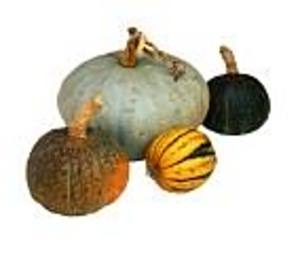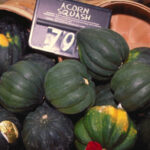In November the supermarkets have a great supply of winter squash. The Acorn Squash is a favorite of mine. The winter squash was a staple of Native Americans. The winter squash may be found in many early burial grounds to provide food for the long trip to meet the Great Spirit. The winter squash comes in various varieties. The squash is sweet and has a fine woven texture unlike the summer Spaghetti Squash another favorite of mine. The Acorn Squash has a deep green exterior with a hint of orange and yellow. The surface is almost impenetrable. The shelf life of a squash is up to six months.
As the winter months have less sunlight, the Acorn Squash supplies valuable nutrients and minerals into the diet. It is very high in Vitamin A. Additionally, the winter squash provides, Vitamin C, Potassium, dietary fiber, manganese, folate, Vitamin B complex, omega 3 fatty acids, copper and tryptophan. You might say the Acorn Squash is a perfect eatable item.
The winter squash is a relative of the cucumber and the melon. The inner sweet fiber of the winter squash has seeds in the center. The trick is to soften the outside layer, so you are able to get to the sweet fiber. This fiber was once a routine aspect of all diets, and for the most part has been driven out by processing and modern taste preferences. It is essential for digestion and has been found a preventive for various forms of cancer, lung disease and all around good health.
The Vitamin A component is good for men’s health as well as smokers. Smoking cigarettes depletes Vitamin A in the system, but further studies need to be conducted. Acorn Squash is abundant in the nutrient beta-carotene. Beta-carotene prevents the oxidation of cholesterol in the vessels. Thus, no plaque develops causing restricted blood flow leading to heart disease.
There are numerous health benefits of the Acorn Squash, but the best thing of all is the taste. According to the World’s Healthiest Foods, the squash is indigenous to Central America. The largest producers of winter squash are Italy, China, Turkey and Egypt. Christopher Columbus discovered the squash in the Americas and returned to Europe with ample seeds and samples.
The Acorn Squash has every imaginable recipe application. I prefer to eat it without pastries, but cookie, pie and other recipes are readily available.
Acorn Squash Straight-Up Recipe
Ingredients:
1) Acorn Squash, weight ½ pound
2) Tablespoons brown sugar
1) Tablespoon butter
3) Tablespoon maple syrup
A Dash of pepper and salt
Preparation:
Preheat an oven to 300 or 325 Fahrenheit
To soften the outside skin, I place the Acorn Squash in a small tub of water, approximately 1/4 the depth of the tub. I place it in a microwave for approximately three minutes. After this process, you will find any good sharp kitchen knife can penetrate the tough surface. After cutting the Acorn Squash horizontally and cleaning out the seeds and excess stringy fiber, rinse out the gourd with cool water.
Place the Acorn Squash on a cooking sheet. Then place the butter, brown sugar and maple syrup in the center of the divided parts of the squash. Sprinkle lightly with salt and a dash of pepper.
I usually bake the Acorn Squash for 30 minutes to 35 minutes, giving the squash ample time to absorb the ingredients. Serve while it is warm from the oven. Top it with low-fat whip cream or fruit or any combination and it is a great perfect food. Even the pickiest eater will enjoy it.




